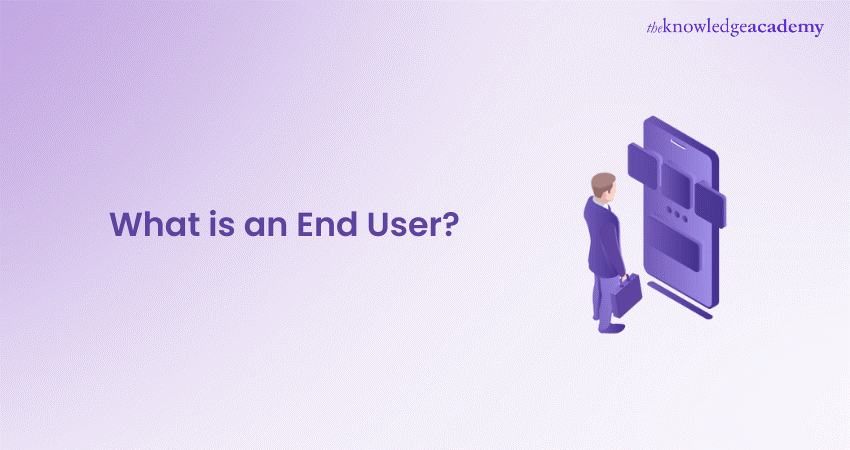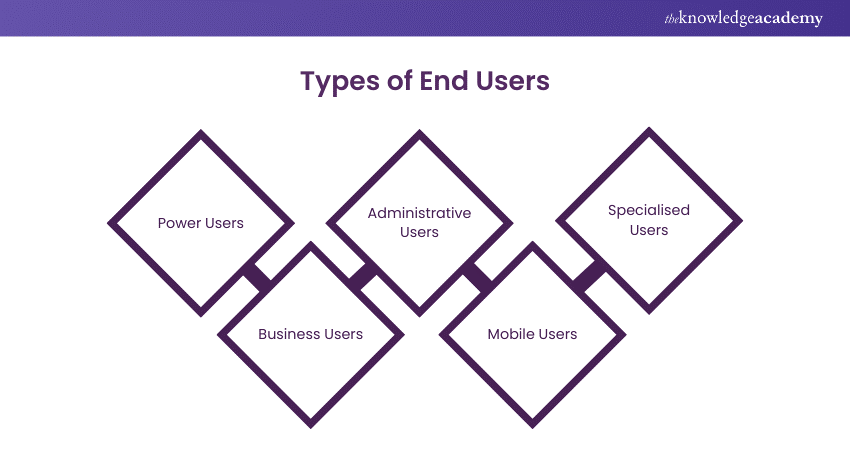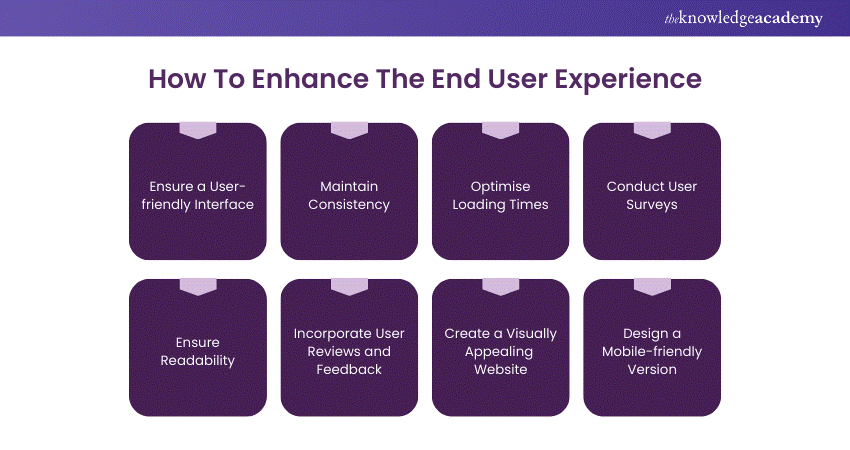We may not have the course you’re looking for. If you enquire or give us a call on +61 1-800-150644 and speak to our training experts, we may still be able to help with your training requirements.
Training Outcomes Within Your Budget!
We ensure quality, budget-alignment, and timely delivery by our expert instructors.

Imagine a world where every product or service is in accordance with your specific needs.As the end user is the ultimatum of a specific product or design in the commercial space. So, who exactly are end users? By understanding their roles, challenges, and preferences, businesses can craft smart, effective solutions that resonate with the end-users. Moreover, throughout the process, you will unlock strategies to transform your end-user experience into a competitive advantage.
Table of Contents
1) What is an End User?
2) Types of End Users
3) The Role of End Users in Product Development
4) How to Enhance the End User Experience?
5) Challenges in Understanding End Users
6) Conclusion
What is an End User?
End-users are the individuals who actually use a product, service, or system, as opposed to customers who purchase it. For example, a company may buy computers (the customer), but the employees who use them daily are the end-users.
Products are designed with end-users in mind to ensure usability and effectiveness. Understanding their needs and preferences is crucial for creating user-friendly products that truly meet their requirements. Focusing on end-users helps businesses build stronger customer relationships, increase satisfaction, and drive better outcomes.
End-users provide essential feedback that can lead to product improvements and innovation. By listening to their insights, companies can refine their offerings, leading to better product adoption, higher customer loyalty, and long-term success. Satisfying end-users not only solves immediate problems but also helps anticipate future needs, contributing to a stronger brand reputation and sustainable business growth.
Types of End Users
In any product or service, end-users can be categorised based on how they interact with the system and their expertise level. Understanding these types helps tailor solutions to meet their needs and enhance their overall experience.

1) Power Users
Power users are highly proficient with the product or service and often utilise advanced features to maximise its potential. They are typically experts or enthusiasts who require high performance, customisation options, and efficiency. Power users provide valuable feedback on the products for their development and aid in expanding the product's possibilities.
2) Business Users
Business users are professionals who use the product or service to improve their productivity and streamline business operations. Therefore, they need reliability, integration with other business tools, and user-friendliness to perform their daily tasks efficiently. However, they might not need advanced features but a product that supports their work and contributes to achieving business goals.
3) Administrative Users
Administrative users are responsible for managing the system, including user access, configuration, and maintenance. They need robust tools to control settings, ensure security, and monitor system performance. These users often require detailed reporting and analytics to manage operations smoothly, which is critical to the overall system’s stability and security.
4) Mobile Users
Mobile users rely on the product or service in transit, using mobile devices to access features and functionalities. They need seamless, intuitive interfaces and fast performance optimised for smaller screens and varying network conditions. These users value portability and accessibility, making it essential for products to offer reliable and user-friendly mobile experiences.
5) Specialised Users
Specialised users possess expertise in specific domains and use the product or service for niche purposes. They require highly specialised features and customisations tailored to their unique needs. These users often work in fields such as engineering, healthcare, or research, where precision and functionality are critical. Products must cater to their specialised requirements for optimal performance.
Enhance your digital workflow with LibreOffice Training- join now!
The Role of End Users in Product Development
End-users are integral to the product development process, as they offer unique insights that can shape the direction and success of a product. Their involvement goes beyond just using the product; they actively contribute to its refinement and improvement. Here’s how end-users play a crucial role in different stages of product development:
1) Collecting Feedback
End-users play a crucial role in product development by providing firsthand feedback. Their insights on usability, performance, and overall experience help the organisation to identify the product's strengths and weaknesses.
This feedback is invaluable for developers and designers, highlighting real-world issues that may not be apparent during the initial design and development phases. By actively listening to end-users, companies can make informed decisions to refine features, enhance user satisfaction, and address any pain points.
Moreover, continuous feedback collection ensures that the product evolves in alignment with user needs, leading to a more prosperous and user-centric solution.
2) Testing the Product
End-users are instrumental in testing the product during development. Unlike internal testing, where scenarios are often controlled, end-user testing involves real-world conditions, revealing how the product performs under diverse circumstances.
End-users can identify bugs, usability issues, and unexpected behaviours that might not surface in a controlled environment. Their participation in beta testing or pilot programs allows developers to make necessary adjustments before a full-scale launch.
This hands-on involvement ensures that the product is not only functional but also intuitive and reliable, ultimately resulting in a more polished and user-friendly final product.
3) Influencing Design and Functionality
End-users significantly influence a product's design and functionality. Their preferences, needs, and challenges guide the development process, ensuring the product aligns with real-world applications.
By understanding how end-users interact with the product, designers can create intuitive interfaces and genuinely useful features. Moreover, end-user input can lead to adding new functionalities or simplifying existing ones, making the product more effective and efficient.
In this way, end-users aid in reshaping a product that is not only aesthetically pleasing but also meets their practical needs.
Transform your workflow with Google G Suite Training- register now!
How to Enhance the End User Experience?
End-user experience is critical to the success of any product or service. However, improving this experience requires a blend of thoughtful design, consistent performance, and active user engagement. Here are some key strategies to enhance the end-user experience:

1) Ensure a User-friendly Interface
A user-friendly interface is essential to empowering a positive end-user experience. To this end, you should simplify navigation, use clear labels, and ensure that key features are easily accessible. An intuitive design reduces confusion and allows users to interact with the product effortlessly.
2) Maintain Consistency
Consistency in design and functionality across all platforms and devices promotes familiarity and trust. By maintaining a consistent look and feel, users can easily learn how to navigate and use the product, leading to a smoother experience.
3) Optimise Loading Times
Fast loading times are crucial for keeping users engaged. Ensure that your website or application opens quickly, as delays can frustrate users and lead to higher bounce rates. Optimise images, scripts, and other elements to enhance speed.
4) Conduct User Surveys
Regular user surveys provide valuable insights into user satisfaction and areas for improvement. By actively seeking feedback, you can address user concerns and refine the product to meet their needs better.
5) Ensure Readability
Clear and concise content improves readability, making it easier for users to understand information. You should utilise legible fonts, appropriate text sizes, and sufficient contrast to ensure that content is accessible to all users.
6) Incorporate User Reviews and Feedback
Incorporating user reviews and feedback into your product development process is crucial. This will allow you to adjust based on real user experiences. Additionally, it will improve the product's quality and reassure users about their valuable opinions.
7) Create a Visually Appealing Website
A visually appealing website enhances the overall user experience (UX) by engaging users and making interactions more enjoyable. To attract and retain users, you should use a balanced colour scheme, attractive graphics, and thoughtful design elements.
8) Design a Mobile-friendly Version
With skyrocketing usage of mobile devices, designing a mobile-friendly version of your website or application is imperative. You must ensure that your product is responsive, with touch-friendly navigation and layouts that work seamlessly on smaller screens.
Elevate your team collaboration with Microsoft SharePoint Training- join now!
Challenges in Understanding End Users
Understanding users is a complex process that involves accurately interpreting their needs, behaviours, and preferences. However, you might be subjected to numerous challenges that hinder this understanding. Here are some of the key challenges that businesses may face:
1) Gathering and Analysing Data
Collecting accurate data often requires sophisticated tools and methods, which can be resource-intensive. Additionally, the sheer volume of data can overpower teams, making it challenging to identify actionable insights.
Furthermore, misinterpreting or overlooking critical data points can lead to decisions that don’t align with user needs, resulting in products that fail to address user expectations and preferences.
2) Misinterpreting User Feedback
Without proper analysis, businesses could focus on outlier opinions rather than the majority’s needs. Additionally, feedback can be influenced by the user’s current emotions or context, making it unreliable if taken at face value.
This misinterpreting feedback can result in changes that do not truly improve the product and instead degrade the user experience by addressing the wrong issues.
3) Insufficient Representation in User Research
Ensuring that user research includes diverse users is not just a challenge; it's a necessity. More representation in user research can skew understanding of the end-user experience. Their findings may be biased or incomplete if research participants do not adequately reflect the diversity of the actual user base.
This further leads to products that solely cater to a narrow segment of users, neglecting the broader market.
Conclusion
Hopefully this blog, ‘What is an end-user' enumerated meaningful and value-driven insights for your career goals. As software developers progressively refine an app based on user feedback to improve functionality and usability, understanding and addressing end-users needs streamline the creation of user-friendly and effective solutions.
Revamp your presentations with Microsoft PowerPoint Training- join today!
Frequently Asked Questions

To identify end users, you should analyse who directly interacts with your product or service. This can be achieved by using user research, surveys, and feedback from current or potential users to understand their needs and behaviours. Additionally, you can leverage observing real-world usage to pinpoint end users effectively.

The end-user process involves creating and refining products or services based on their needs, behaviours, and feedback. It includes research, design, testing, and continuous improvement to establish the product meets user expectations and provides a positive experience.

The Knowledge Academy takes global learning to new heights, offering over 30,000 online courses across 490+ locations in 220 countries. This expansive reach ensures accessibility and convenience for learners worldwide.
Alongside our diverse Online Course Catalogue, encompassing 17 major categories, we go the extra mile by providing a plethora of free educational Online Resources like News updates, Blogs, videos, webinars, and interview questions. Tailoring learning experiences further, professionals can maximise value with customisable Course Bundles of TKA.

The Knowledge Academy’s Knowledge Pass, a prepaid voucher, adds another layer of flexibility, allowing course bookings over a 12-month period. Join us on a journey where education knows no bounds.

The Knowledge Academy offers various End User Training, including the Earned Value™ Management Foundation and Practitioner Course, and the Earned Value™ Management Foundation Course. These courses cater to different skill levels, providing comprehensive insights into End User License Agreement.
Our Office Application Blogs cover a range of topics related to Earned Value Management, offering valuable resources, best practices, and industry insights. Whether you are a beginner or looking to advance your Project Management skills, The Knowledge Academy's diverse courses and informative blogs have got you covered.
Upcoming Office Applications Resources Batches & Dates
Date
 Computer Science Course
Computer Science Course
Fri 24th Jan 2025
Fri 21st Mar 2025
Fri 2nd May 2025
Fri 27th Jun 2025
Fri 29th Aug 2025
Fri 3rd Oct 2025
Fri 5th Dec 2025







 Top Rated Course
Top Rated Course



 If you wish to make any changes to your course, please
If you wish to make any changes to your course, please


